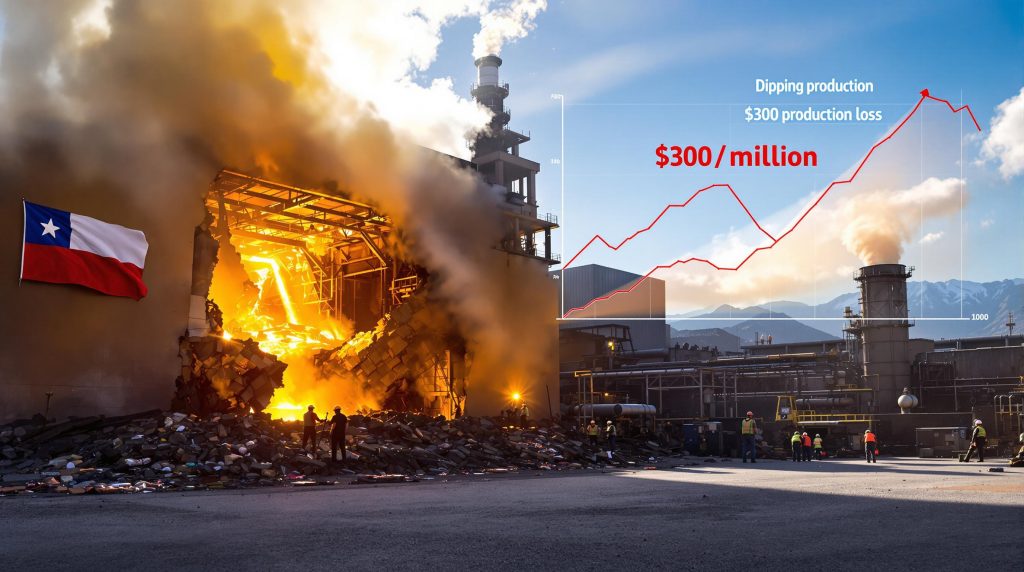Codelco's El Teniente Smelter Restart: Recovery After Deadly Collapse
The copper mining industry faced a significant setback when a catastrophic collapse occurred at Codelco's El Teniente copper mine in Chile. This unfortunate incident, which claimed the lives of six workers, led to an immediate shutdown of smelting operations at one of the world's largest underground copper mines. After nearly two weeks of inactivity, the facility is now preparing for a restart, raising important questions about safety, production impacts, and the future of copper price prediction in global markets.
What Happened at El Teniente's Smelter?
The Deadly Collapse Incident
In late July 2025, tragedy struck at Codelco's El Teniente copper mine when a devastating structural collapse killed six workers at the facility's smelter. This shocking incident prompted immediate action from Codelco management, who ordered a complete shutdown of smelting operations while authorities began investigating the cause of the collapse. The smelter remained inactive for nearly two weeks as teams worked to understand what went wrong and implement necessary safety measures.
The incident represents one of the most serious safety failures in recent Chilean mining history, raising concerns about structural integrity, maintenance protocols, and safety oversight at one of the country's most important industrial facilities. While the exact cause remains under investigation, the human toll has cast a shadow over Chile's mining sector.
Impact on Copper Production
The unexpected shutdown created significant disruptions to copper output at this crucial facility. According to Codelco Chairman Maximo Pacheco, the temporary closure resulted in production losses of approximately "20,000 to 30,000 metric tons of copper, worth about $300 million" (Reuters reported, August 14, 2025).
This substantial financial impact comes at a particularly challenging time for Codelco, Chile's state-owned mining company, which has been facing:
- Declining ore grades at aging mines
- Increasing production costs
- Growing international competition
- Pressure to modernize operations
For context, the production loss represents a significant portion of monthly output from Chile's copper mining operations, affecting not only Codelco's financial performance but potentially impacting global copper supply outlook during a period of high demand for the metal.
How Will the Smelter Restart Process Work?
Restart Timeline and Safety Protocols
The El Teniente smelter is scheduled to resume operations on August 14, 2025, following the nearly two-week shutdown period. While specific details about the restart protocols haven't been publicly disclosed by Codelco, standard industry practice for restarting a copper smelter after such an incident typically involves:
- Comprehensive structural integrity assessments
- Equipment testing and certification
- Implementation of enhanced safety monitoring systems
- Staged operational resumption to ensure stability
The restart comes as the investigation into the collapse continues, indicating that preliminary safety assessments have been completed to a level that satisfies regulatory requirements for resuming operations. Mining industry experts often note that restart procedures after fatal incidents involve heightened scrutiny from both internal safety teams and external regulators.
Operational Challenges During Restart
Restarting a copper smelter after an extended shutdown presents numerous technical challenges that the El Teniente team must carefully navigate. These typically include:
- Thermal management – Carefully reheating refractory linings to prevent thermal shock and cracking
- System integrity verification – Testing all operational systems before processing ore
- Bottleneck prevention – Managing the flow of materials to prevent process congestion
- Enhanced monitoring – Implementing additional oversight during initial restart phases
The restart process must balance the urgent need to resume production with the paramount importance of ensuring worker safety. Given the fatal nature of the recent incident, operations teams will likely proceed with extraordinary caution during the initial restart phase, potentially resulting in a gradual return to full production capacity.
Why Is This Restart Significant for Chile and Global Copper Markets?
El Teniente's Importance to Codelco
El Teniente, located approximately 80 kilometers south of Santiago, holds immense strategic importance for both Codelco and Chile's national economy. As Codelco's largest operation and one of the world's most significant underground copper mines, El Teniente has been in continuous operation for over a century, becoming a cornerstone of Chile's copper industry.
The mine represents a substantial portion of Codelco's production portfolio and serves as a symbol of Chile's mining heritage. With its extensive underground tunnel network and massive scale, El Teniente has historically been a reliable producer despite the challenges of operating an aging mining complex.
Impact on Global Copper Supply
The temporary shutdown at El Teniente contributed to supply concerns in an already tight global copper market. Copper plays an increasingly crucial role in the worldwide energy transition, serving as an essential component in:
- Electric vehicle manufacturing
- Renewable energy infrastructure
- Power transmission systems
- Energy storage solutions
With production losses estimated at 20,000-30,000 metric tons, the El Teniente shutdown temporarily removed significant supply from global markets at a time when copper inventories were already under pressure. While the restart will gradually restore this supply, the incident highlights the vulnerability of global copper markets to disruptions at major production centers.
Chile's Copper Industry Challenges
This incident occurs against a backdrop of broader challenges facing Chile's copper industry:
- Resource depletion – Many of Chile's largest mines are experiencing declining ore grades, requiring more extensive processing for the same copper output
- Water scarcity – Mining operations in Chile's arid regions face growing constraints on water availability
- Energy costs – Rising energy prices impact production economics
- Labor relations – Ongoing negotiations with mining unions influence operational stability
- Environmental regulations – Stricter environmental standards require operational adjustments
These systemic challenges, combined with the immediate impact of the El Teniente incident, create a complex operating environment for Chile's copper producers. The country's position as the world's leading copper producer faces increasing pressure from both internal constraints and external competition.
What Safety Concerns Remain at El Teniente?
Ongoing Investigation
While the smelter is restarting operations, the investigation into the cause of the deadly collapse continues. As of August 14, 2025, no public announcements have been made regarding preliminary findings of what caused the structural failure that claimed six lives. Mining safety investigations typically examine multiple potential factors, including:
- Structural design and engineering assessments
- Maintenance record analysis and compliance verification
- Operational procedure reviews and adherence evaluation
- Employee training and safety protocol implementation
- Environmental factors that may have contributed to the failure
The thoroughness of this investigation will be crucial not only for preventing similar incidents at El Teniente but also for identifying potential safety concerns at other mining operations with similar infrastructure or processes.
Industry-Wide Safety Implications
The El Teniente incident raises broader questions about safety standards across Chile's mining sector. While the country has generally improved its mining safety record over recent decades, underground mining operations inherently carry significant risks that require constant vigilance.
Industry safety experts often point to several common challenges in modern mine planning and safety management:
"Underground mining environments combine unique hazards including ground instability, confined spaces, heavy machinery operation, and complex ventilation requirements. Each of these factors requires specialized safety protocols that must be continuously updated and rigorously enforced."
The restart of El Teniente's smelter operations while the investigation continues suggests a delicate balance between production imperatives and safety considerations. How Codelco manages this balance will likely influence industry practices beyond this specific facility.
How Does This Incident Affect Codelco's Future Plans?
Financial Impact on Transformation Efforts
The $300 million production loss creates additional financial pressure on Codelco at a critical time. The state-owned mining company has been implementing an ambitious transformation plan aimed at extending the life of its aging mines and reversing declining production trends. This major investment initiative faces new challenges with each significant production disruption.
The financial impact goes beyond the immediate production loss:
- Insurance and liability costs related to the incident
- Potential regulatory penalties or compliance requirements
- Increased safety implementation expenses
- Productivity impacts from enhanced safety protocols
- Potential delays to scheduled modernization projects
For Codelco, which operates as both a commercial enterprise and a source of national revenue for Chile, balancing these financial pressures while maintaining safety standards presents a significant management challenge.
Balancing Production and Safety
The incident highlights the ongoing tension between maintaining production levels and ensuring worker safety. As Codelco works to increase efficiency and output across its operations, this tragedy serves as a stark reminder of the human cost when safety is compromised.
Mining companies globally face similar challenges in balancing:
- Production targets and shareholder expectations
- Worker safety and well-being
- Community impacts and social license
- Environmental responsibility
- Long-term sustainability
How Codelco responds to this incident in terms of operational practices, safety investments, and corporate culture will likely define its trajectory for years to come. The company's leadership faces difficult decisions about prioritizing immediate production recovery versus implementing more comprehensive safety reforms.
Environmental and Community Considerations
Beyond the immediate production and safety concerns, the incident may also prompt renewed scrutiny of Codelco's environmental practices and community relations. Mining disasters often catalyze broader discussions about the industry's social license to operate.
Local communities surrounding El Teniente may seek:
- Greater transparency about operational risks
- Enhanced emergency response capabilities
- Improved communication about safety incidents
- More community involvement in safety oversight
- Additional investments in community infrastructure
These social dimensions of mining operations have become increasingly important for major producers like Codelco, particularly as Chile's citizens demand higher standards of corporate responsibility from state-owned enterprises.
What Does This Mean for Copper Prices?
Short-Term Market Response
The temporary production loss from El Teniente has contributed to tightness in the global copper market. The 20,000-30,000 metric ton reduction in supply, while representing a small percentage of global production, occurred during a period of relatively low inventory levels in copper markets.
Market analysts track several key indicators when assessing the impact of such disruptions:
- LME and COMEX warehouse inventory levels
- Spot market premium movements
- Forward curve structure changes
- Regional price differentials
- Trade flow adjustments
With the smelter now restarting, any price premium specifically related to this disruption may gradually diminish as supply normalizes. However, the incident adds to a pattern of supply disruptions that collectively influence market sentiment about Codelco's El Teniente smelter restart after collapse.
Long-Term Supply Outlook
The incident at El Teniente underscores the vulnerability of global copper supply to unexpected disruptions. As demand for copper continues to grow due to its essential role in the energy transition, the resilience of production facilities becomes increasingly important to market stability.
Several factors influence the long-term outlook for copper supply:
- Aging infrastructure – Many major copper mines and processing facilities globally are operating with aging infrastructure that requires significant maintenance and eventual replacement
- Resource nationalism – Growing trends toward government intervention in mining sectors across major producing regions
- Project development timelines – The extended period required to bring new copper projects online
- Technical challenges – Declining ore grades requiring more processing for the same output
- Climate impacts – Increasing frequency of extreme weather events affecting mining operations
These structural factors, combined with incident-driven disruptions like the El Teniente collapse, create a complex supply picture for copper markets that will influence copper investment strategies in coming years.
Lessons Learned and Path Forward
Safety Culture Evolution
The El Teniente incident will likely accelerate discussions about safety culture in Chile's mining industry. Safety experts frequently emphasize that preventing catastrophic failures requires more than technical compliance—it demands a cultural commitment to safety at all organizational levels.
Key elements of effective mining safety culture include:
- Proactive hazard identification – Encouraging workers to report potential safety issues without fear of reprisal
- Transparent incident reporting – Creating systems for honest assessment of near-misses and accidents
- Continuous learning – Implementing lessons from incidents across the organization
- Leadership accountability – Ensuring management takes responsibility for safety outcomes
- Worker empowerment – Providing authority to stop work when unsafe conditions are identified
How Codelco addresses these cultural elements following the El Teniente incident will likely influence safety practices across Chile's mining sector.
Technological Solutions for Prevention
The incident may accelerate adoption of advanced technologies designed to prevent structural failures and enhance worker safety in mining environments. Modern mines increasingly deploy:
- Structural health monitoring systems using vibration analysis
- Real-time deformation detection using laser and radar technologies
- Predictive maintenance algorithms to identify potential failures before they occur
- Remote operation technologies to reduce human exposure in high-risk areas
- Advanced warning systems for imminent structural issues
Investing in these technologies represents both a significant cost and a potential competitive advantage for mining companies seeking to minimize production disruptions while protecting worker safety.
FAQs About the El Teniente Smelter Restart
How long was the El Teniente smelter offline?
The smelter was shut down for nearly two weeks following the collapse in late July 2025, with operations scheduled to resume on August 14, 2025.
What was the financial impact of the shutdown?
According to Codelco Chairman Maximo Pacheco, the shutdown resulted in a loss of 20,000 to 30,000 metric tons of copper production, valued at approximately $300 million (Mining Weekly, Reuters, August 14, 2025).
Has Codelco identified the cause of the collapse?
As of the smelter restart announcement, the investigation into the cause of the collapse that killed six workers was still ongoing, with no public announcements regarding specific findings.
How significant is El Teniente to Chile's copper production?
El Teniente is Codelco's largest operation and one of the world's biggest underground copper mines, making it a crucial contributor to Chile's position as the world's leading copper producer.
What safety measures is Codelco implementing before restarting operations?
While specific details haven't been publicly disclosed, standard industry practice would include comprehensive structural inspections, equipment testing, and enhanced safety protocols before resuming operations after such an incident.
How might this incident affect Codelco's transformation plans?
The financial impact of the production loss creates additional pressure on Codelco's transformation efforts aimed at extending mine life and reversing production declines at its aging operations.
Looking Ahead: Monitoring the Restart
The coming weeks will be critical for Codelco as El Teniente's smelter returns to operation. Industry observers will be watching several key indicators:
- The pace of production ramp-up following the restart
- Any announcements regarding the ongoing safety investigation
- Worker and union responses to safety measures
- Regulatory oversight and potential new requirements
- Market response to the restoration of supply
The incident at El Teniente serves as a sobering reminder of the human cost behind copper production and the constant vigilance required to maintain safety in mining operations. As the global energy transition increases demand for copper, balancing production imperatives with worker safety will remain an essential challenge for producers worldwide. Furthermore, the impact on US copper production overview remains to be seen as global markets adjust to this significant disruption at one of the world's premier copper facilities.
Looking for Major Mining Investment Opportunities?
Discover significant ASX mineral findings before the market with Discovery Alert's proprietary Discovery IQ model, which transforms complex mineral data into actionable insights for investors. Explore why historic discoveries can generate substantial returns by visiting Discovery Alert's dedicated discoveries page.




